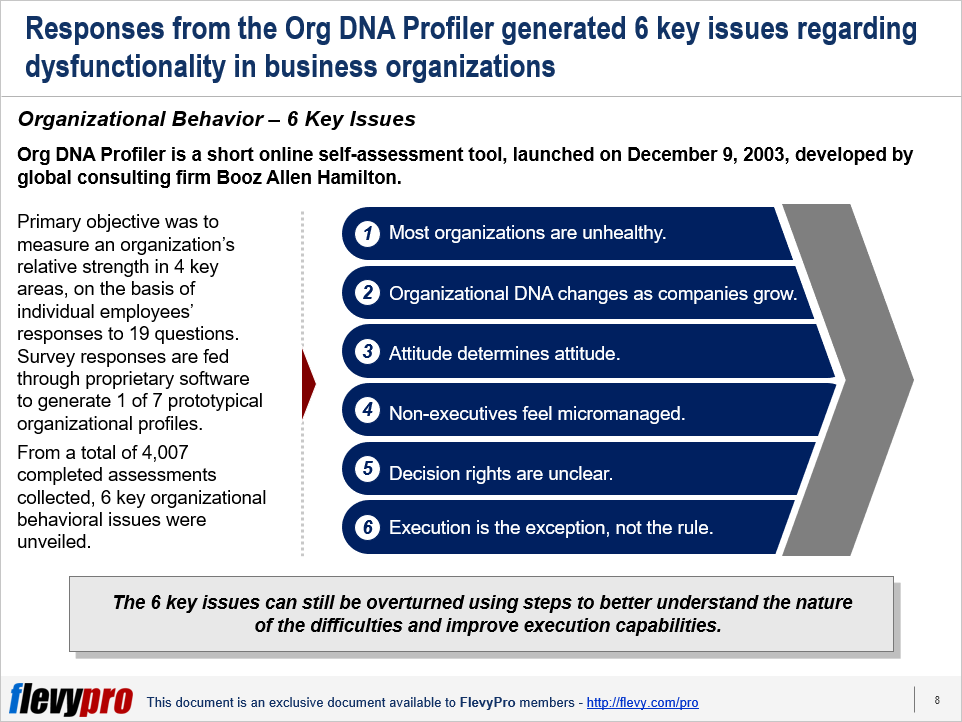Most organizations are unhealthy. Only organizations that are recognized to be Resilient, Just-in-Time, and Military can be described and relatively free from dysfunction. Yet, only 27% of the responses gathered from the Org DNA Profiler showed a healthy profile.
and relatively free from dysfunction. Yet, only 27% of the responses gathered from the Org DNA Profiler showed a healthy profile.
The Org DNA Profiler is a short online self-assessment tool launched on December 9, 2003. It was used to measure an organization’s relative strength in 4 key areas, on the basis of individual employees’ responses to 19 questions. From a total of 4,007 completed assessments collected, there were 6 Organizational Behavioral issues that were prompted. These issues can still be turned around by undertaking the appropriate step.
The 6 Key Issues on Organizational Behavior
Organizational Behavioral Issues are observations on the prevalence of dysfunctions among business organizations.
- Most organizations are unhealthy. More than 60% of the organizations are either Passive-Aggressive, Fits-and-Starts, Outgrown, or Overmanaged.
- Organizational DNA changes as companies grow. Small companies report more Resilient and Just-in-Time behaviors. They become more centralized and demonstrate Military traits as they grow. Once annual revenues cross the $101B threshold, decentralization occurs. However, often this is undertaken badly.
- Attitude determines attitude. There are sharp differences between senior management and lower-level personnel. A disconnect exists between the organizations that senior executives believe they have established and the organizations they are actually running.
- Non-executives feel micromanaged. Junior managers feel a lack of maneuvering room compared to senior managers who view their self-professed involvement in operating decisions as good.
- Decision rights are unclear. More than 50% of the respondents believe that the accountability for decisions and actions in their organizations was vague.
- Execution is the exception, not the rule. Less than 50% of the respondents agreed that important strategic and operational decisions are quickly translated into action in their organizations.
It is expected that all organizations have behavioral issues. However, unlike humans and other organisms, organizations can change their DNA by adjusting and adapting their building blocks and resolve these issues. There are just processes that organizations must take into consideration to effectively address these behavioral issues and turn them around for the benefit and advantages of the organization.
The Need to Unlearn, Learn, and Relearn
It is advisable for an organization to continue to analyze its organization as it grows into and occasionally out of dysfunction. This can be done by using a 4-step evolutionary process.
Step 1: $0 - $500 Million. The first step or Step 1 generally demonstrates characteristics depicting Resilient or Just-in-Time profiles.
Organizations at this level are effective at executing and adapting to changes in the environment. They are generally younger small companies that are attuned to and aligned with the vision and strategy of the founders. They are known to be able to adapt more nimbly to market shifts.
Step 2: $500 Million - $1 Billion. The second step is an evolutionary phase where organizations are starting to experience the adverse effect of growth in terms of size. This is basically the stage where Military profile has reached its peak in revenue segment. These are the organizations that are bureaucratic, slow, and overly politicized. At this point, expanding middle management starts to second guess and interfere in lower-level decision making.
Step 3 is where organizations are becoming too large and step 4 is returning back to a Resilient profile. The 4-step evolutionary process reflects the stages of development of organizations as they start from being small to being large and complex. It is a reflection of the issues they are encountering at each step of development that they are in. Knowing where they are at this point will enable an organization to better undertake their Strategy Development in a most effective approach.
Interested in gaining more understanding of Organizational Behavioral Issues? You can learn more and download an editable PowerPoint about Organizational Behavioral Issues here on the Flevy documents marketplace.
Are you a management consultant?
You can download this and hundreds of other consulting frameworks and consulting training guides from the FlevyPro library.

Comments